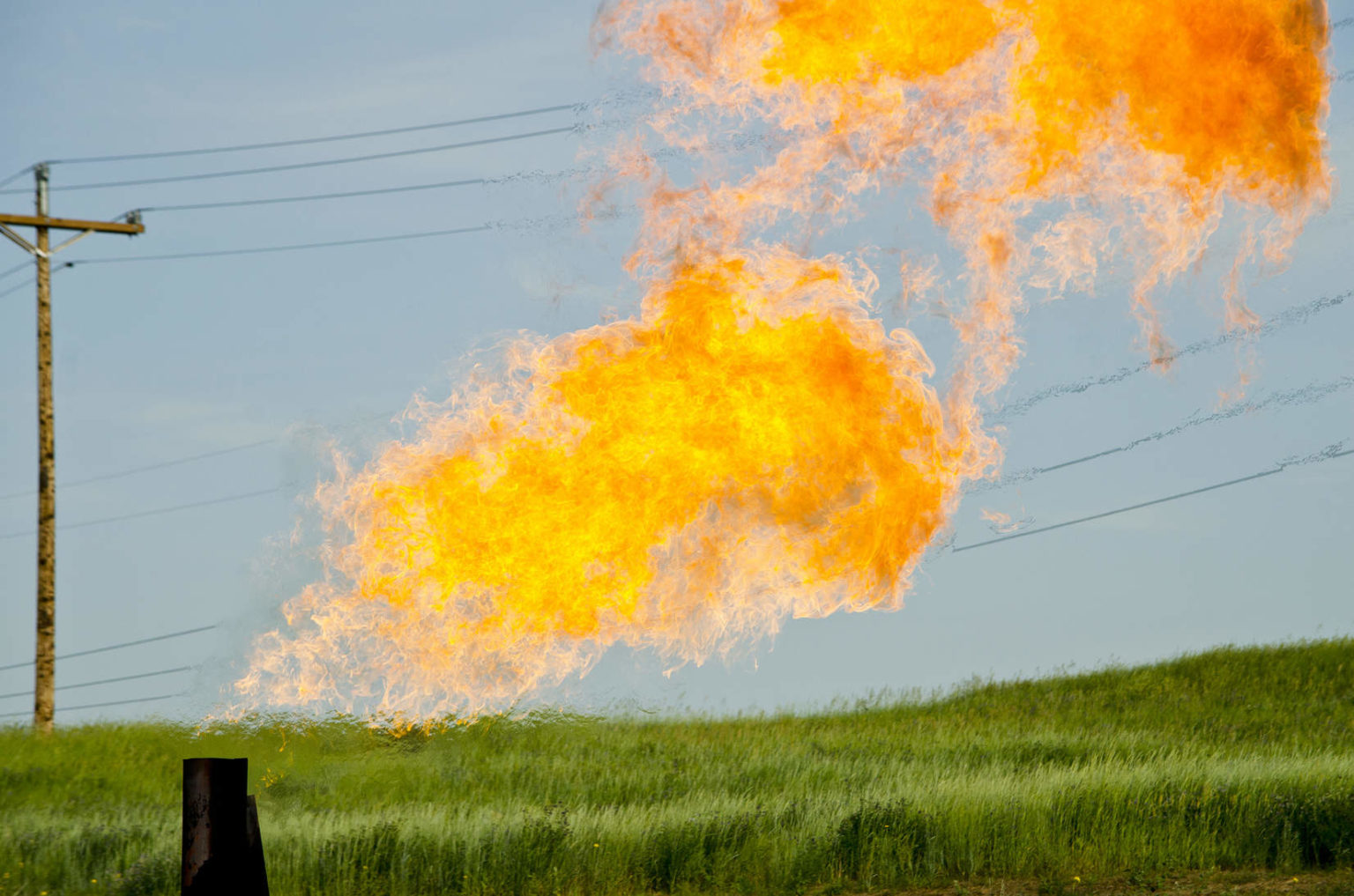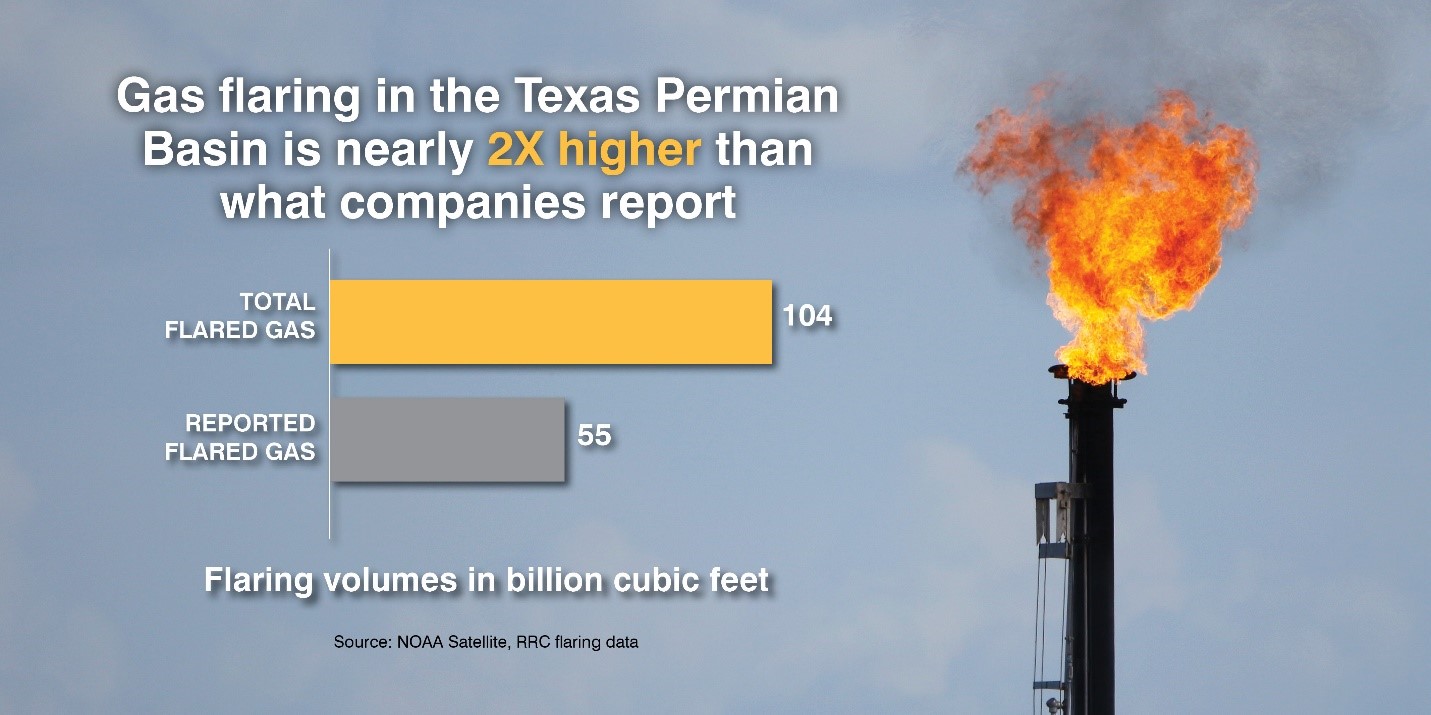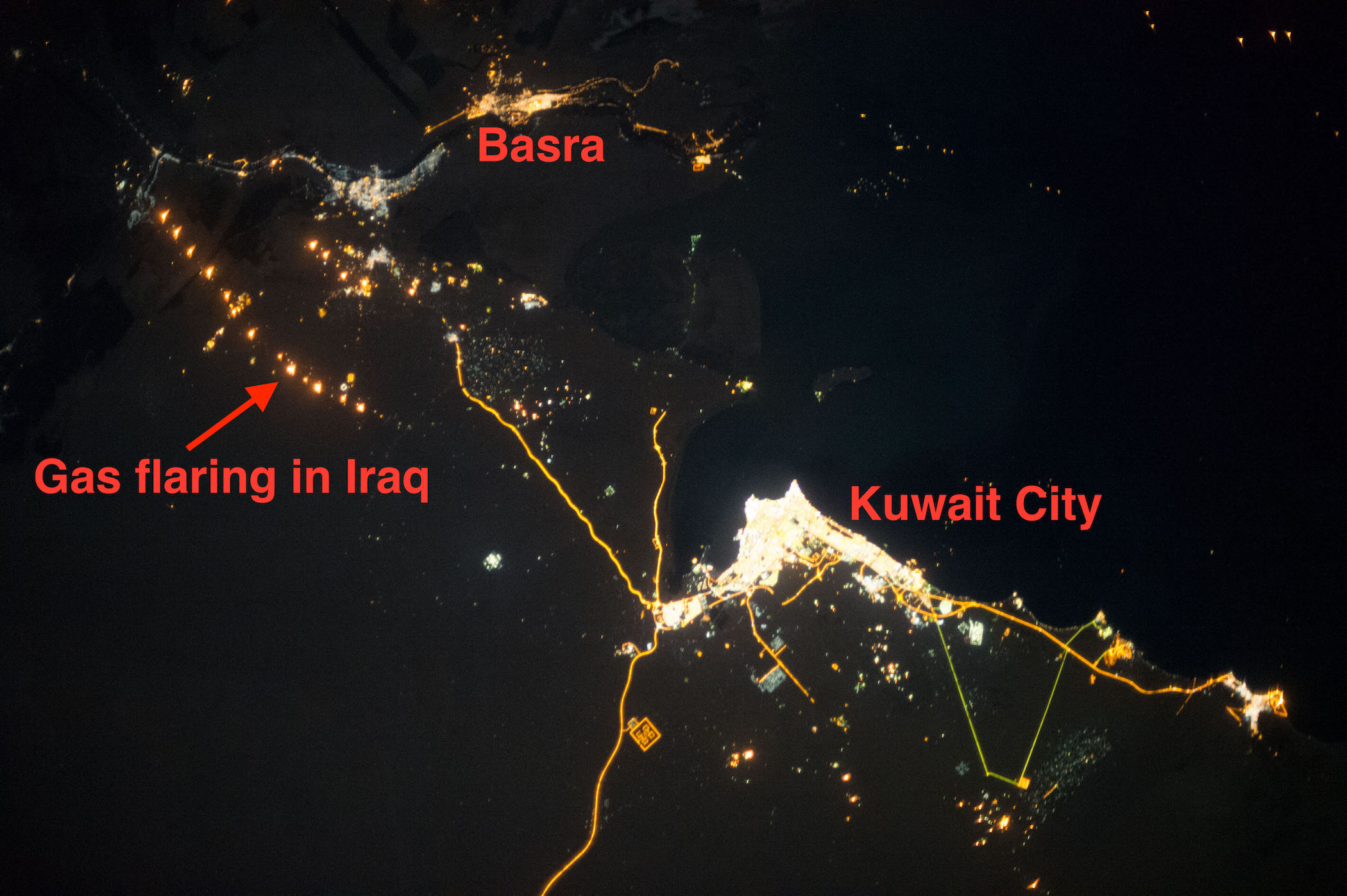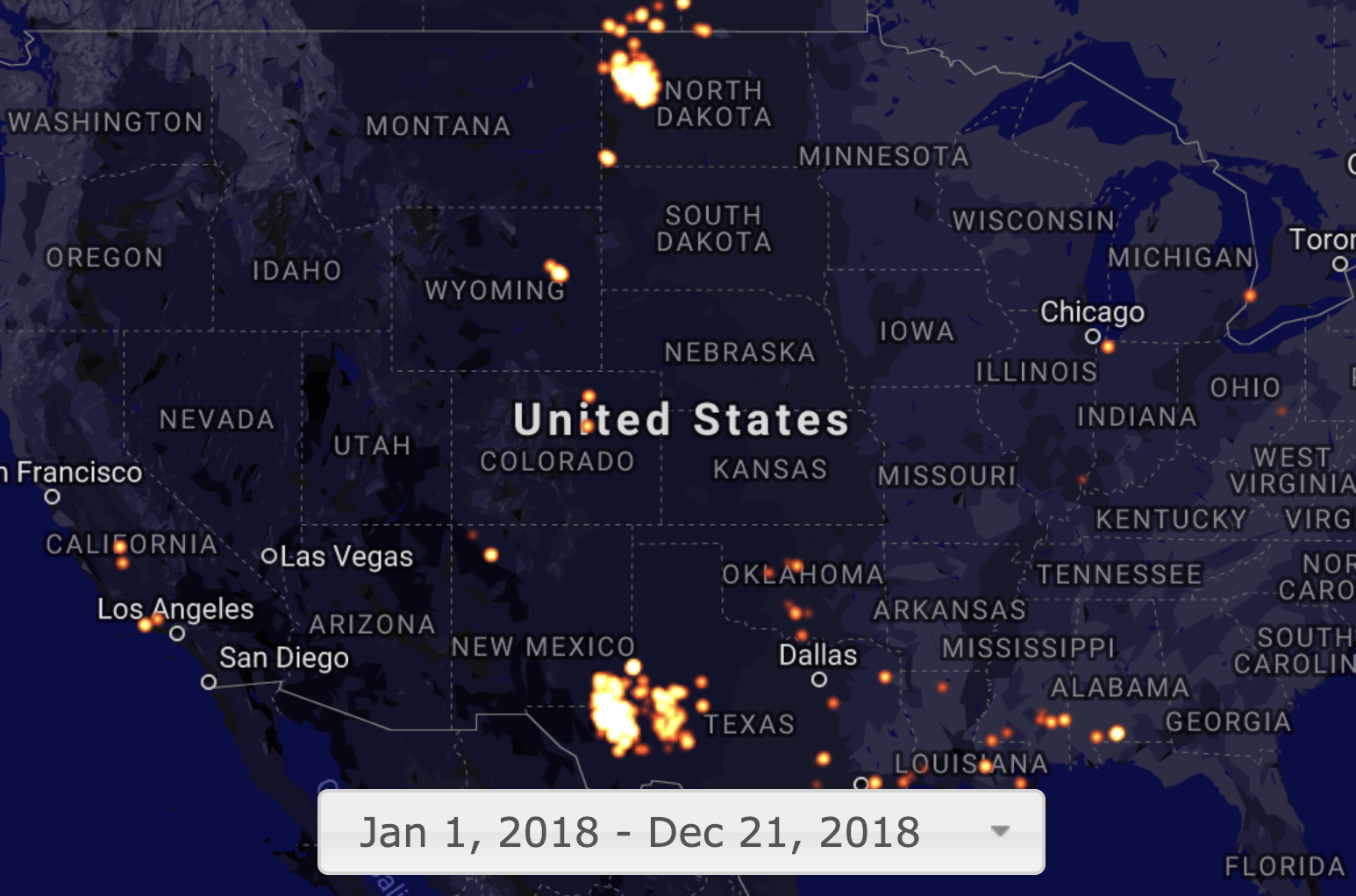In 2018, the oil and gas industry operating in North Dakota’s Bakken Shale burned off record amounts of natural gas, largely obtained via hydraulic fracturing (fracking). This process, known as flaring, costs the industry money — it literally burns one of the products being pumped out of the ground — but more importantly, the resulting release of globe-warming emissions of carbon dioxide and methane spells disaster for the climate.
And a new analysis of satellite evidence indicates the industry is likely underreporting how much gas it is actually flaring in the Permian Shale, with implications for other oil fields.
According to the Bismarck Tribune, the amount of gas flared in North Dakota in October was enough to heat 4.25 million homes in America. And while the fracking industry in North Dakota is flaring the most gas in the nation, it’s not the only place this is a growing issue. Flaring reportedly also doubled in 2018 in the booming Permian Shale in Texas and New Mexico, with an estimated $1 million a day of gas burned off.
In addition, the Environmental Defense Fund (EDF) recently analyzed satellite data and concluded that the industry is likely underreporting the actual volumes of gas flared in the Permian. EDF says that the real numbers are closer to double what the industry reports.
Differences in reported versus unreported gas flaring in the Permian Basin in Texas. Credit: Environmental Defense Fund
This increase in flaring is just one more example of how the oil and gas industry has recklessly pushed forward with the so-called “shale revolution,” producing record amounts of oil while losing money and showing blatant disregard for the environment and climate along the way. It is also an excellent example of how federal and state regulators are allowing this to happen.
Fracking Oil in America Means Flaring Gas
Flaring has alway been a part of oil production, conventional or otherwise. Natural gas often is found with oil reservoirs and when adequate infrastructure doesn’t exist to capture both the oil and gas, the gas is flared, or burned, while the oil is captured and sold. (Natural gas is primarily methane, a powerful greenhouse gas, and burning it transforms the methane to water and carbon dioxide, which is perhaps the best-known greenhouse gas.)
Flaring did not begin with fracking’s modern introduction to oil and gas fields, but the rush to develop shale fields via fracking seems to have encouraged the practice in recent years. For comparison, let’s look at Iraq.
In Iraq, where the oil industry has been rebuilding after the damages of the Iraq War, production currently falls between 4 and 5 million barrels of oil per day, using conventional drilling methods. Compare that with the approximately 4 million barrels per day of oil produced via fracking in the Permian Basin.
Iraq’s industry has been flaring billions of dollars of gas because there is no infrastructure to capture it, a situation companies there are moving to remedy but one which will require large investments in gas processing facilities. Iraq is working with several foreign corporations to construct the infrastructure and aims to end flaring by 2021, a move projected to save over $5 billion in the next four years.
Original image: Gas flaring in southern Iraq in 2014. Credit: NASA Earth Observatory, public domain
However, the companies fracking for oil in America’s major shale plays appear less interested in building adequate capacity, which hasn’t been built in the first place, to capture the gas they currently flare. This isn’t a technological problem.
A new report from the Energy and Environmental Research Center (EERC) at the University of North Dakota suggests that North Dakota should capture the gas and store it underground, a common method of storing gas. But as the Aliso Canyon disaster made clear when an uncontrolled leak spewed methane from a gas storage facility in southern California for several months, the approach is not without its risks. However, it is the cheapest option.
John Harju, vice president for strategic partnerships at the EERC, told the Associated Press that capturing the gas and using pipelines to move it to processing facilities is always the ideal way to handle it. However, the best option is often the most expensive option.
“The economics aren’t great, but it is economic under the right circumstance,” Lynn Helms, the director of North Dakota’s Department of Mineral Resources, said of the proposed underground gas storage plan, according to the trade publication Natural Gas Intel.
If the industry can make money capturing the gas, it will. If not, it will continue flaring.
North Dakota’s Flaring Guidelines Do Little to Reduce Flaring
In April 2018, North Dakota updated its flaring regulations based on changes “submitted by an industry group” that were supposed to result in reduced flaring. The state’s main oil and gas industry lobbying group is the North Dakota Petroleum Council (NDPC), which is supported by the American Petroleum Institute.
According to The Associated Press, Kari Cutting, NDPC vice president, reportedly told the newspaper that the “oil industry is committed to meeting the flaring targets, even if it means cutting back on crude production.”
“We’ll do what we have to do,” Cutting said.
However, the language in the new guidelines actually gave the oil companies more options to flare. For example, according to the guidelines: “The initial horizontal well drilled … should be allowed to produce at its maximum efficient rate, regardless if the well is connected to a gas gathering system.” [Emphasis added.]
Predictably, North Dakota set records for oil production and flaring in 2018, after the new flaring guidelines were announced. So much for the oil industry’s commitment to reducing flaring even if it requires reducing oil production.
North Dakota oil production may decline in 2019 but that would be tied more to the drop in oil prices in late 2018.
CORRECTION:
Bakken Flared Gas Has Quadrupled from 0.12 to 0.5 billion cf/day since April 2016
& accounts for 20% of total gas produced.#OOTT #NaturalGas #shale #fintwit #oilandgas pic.twitter.com/OYLUBQYZoI— Art Berman (@aeberman12) January 23, 2019
And with an estimated $10 billion more in infrastructure needed to address the North Dakota flaring issues, the fracking industry, which continues to lose money, especially with current low oil prices, appears unlikely to address flaring on a significant scale any time soon.
Ron Ness, president of the NDPC, confirmed this in remarks to the Bismarck Tribune, saying the necessary investment wasn’t going to come “right away” because “[o]ur productivity has just outpaced the expectations on gas so much.”
And so flaring will continue on the Great Plains.
Federal Regulations on Flaring and Venting Natural Gas Repealed
At the end of the Obama administration in 2016, the Bureau of Land Management released new regulations “to reduce waste of natural gas from venting, flaring, and leaks during oil and natural gas production activities on onshore Federal and Indian leases.”
After Trump took over, however, the agency decided to review this new rule and in October 2018 released a revised, relaxed form of those regulations.
At the time of the release, David Bernhardt, now the acting Secretary of the Interior, explained the purpose of the changes: “We’re fulfilling a commitment to a policy vision the president established to promote clean development of our resources without regulation that encumbers business, restrains growth, and prevents job creation.”
Satellite image of U.S. flaring in 2018. Credit: SkyTruth
The Midland Reporter-Telegram, a newspaper in the heart of the Permian, summarized the gutting of the Obama-era regulations, which included the removal of “requirements pertaining to waste minimization plans, gas-capture percentages, well drilling, well completion and related operations, pneumatic controllers, pneumatic diaphragm pumps, storage vessels, and leak detection and repair.”
Or as Matt Watson of the Environmental Defense Fund explained to The New York Times: “This is a complete dismantling of federal methane regulation in the United States.”
One of the main arguments for weakening these natural gas and methane regulations was that implementing them would have been cost prohibitive for some small oil and gas producers and would have caused them to stop operations.
Fracking’s Many Climate Impacts
“Drilling Towards Disaster,” a new report by Oil Change International, outlines how fracking is driving oil and gas production in America (and being exported to the rest of the world) and the dangers this poses by driving future climate impacts at a time when rapid decarbonization of the global economy is required.
By essentially providing no real limitations on flaring, state and federal regulators are allowing the oil and gas industry to produce record amounts of oil, which accelerates climate change when the oil is burned. However, the situation also releases additional carbon dioxide when the gas is flared, without providing any economic benefit, such as powering millions of American homes.
Additionally, the methane that is leaked in the supply chain, and in some cases intentionally vented into the atmosphere, adds to global warming. Methane traps more heat than carbon dioxide in the short term.
And even with the Trump administration rolling back a number of environmental regulations like the rules for methane flaring and venting, the oil and gas industry is looking for still more deregulation from the federal government.
With the federal government now open after a 35-day-long shutdown, it’s back to business as usual.
Main image: Natural gas flares from a flare-head at the Orvis State well on the Evanson family farm in McKenzie County, North Dakota. Credit: Tim Evanson, CC BY–SA 2.0
Subscribe to our newsletter
Stay up to date with DeSmog news and alerts









